|

Here's a wonderful way to make an extra
connection with your child!
Make these musical instruments from everyday items together, and when you're
done, you can use them to sing a song!
 Plastic
Egg Shakers Plastic
Egg Shakers

MATERIALS:
 Plastic
Easter eggs Plastic
Easter eggs
 Filling-
rice and barley are recommended, but you can also fill different eggs Filling-
rice and barley are recommended, but you can also fill different eggs
with different things and have children
compare sounds
 Hot
glue gun, and hot glue Hot
glue gun, and hot glue
INSTRUCTIONS:
Put a couple of
tablespoons (you can experiment with sound before sealing) of rice or other
filling in bottom half of egg. Run a bead of hot glue along the inside edge
of the TOP of the egg. Carefully place top on and check to be sure it’s on
straight and tight.
COMMENTS:
The larger size egg is fun, but if you use eggs the size of real eggs, you
can store them in egg cartons painted to match the egg colors, and children
can sort them when putting them away.

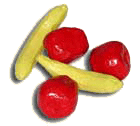 Paper
Mache Fruit Shakers Paper
Mache Fruit Shakers

MATERIALS:
 Vegetable
spray or cooking oil Vegetable
spray or cooking oil
 Pieces
of fruit Pieces
of fruit
 Newspaper
torn in to small pieces Newspaper
torn in to small pieces
 Large
tray to catch mess Large
tray to catch mess
 Paste
made of 3 parts water to 1 part white glue Paste
made of 3 parts water to 1 part white glue
 Acrylic
paints and clear finish material (water-based Polyurethane is Acrylic
paints and clear finish material (water-based Polyurethane is
recommended)
 Paint
brushes Paint
brushes
 Disposable
gloves (optional, but very nice to have!) Disposable
gloves (optional, but very nice to have!)
INSTRUCTIONS:
Put a thin coating of
vegetable spray or oil on piece of fruit. Dip pieces of newspaper in glue or
starch, removing excess by pulling paper between fingers. Completely cover
fruit with several layers of newspaper. Allow to dry for a couple of days.
Cut fruit in half with a serrated knife, and remove fruit and skin. Discard
or compost. Put rice other filler in paper fruit, and use small amount of
masking tape to seal halves together. Repeat with several more layers of
glue-dipped newspaper, and again allow to dry. You can lightly sand any
rough edges before painting. Paint with appropriate fruit colors, and seal
with Polyurethane.
COMMENTS:
Find songs that mention the fruits you are using, and fruit
can be played every time that fruit is mentioned. example:
I Like to Eat Apples and Bananas and Mango Fandango
( can be found on
Rhythm of the Rocks, by
MaryLee and Nancy, available in my
Online
Shop), and of course,
Shake, Shake, Shake Your Apples,
the free September 2002
Song of the Month on NancyMusic.com

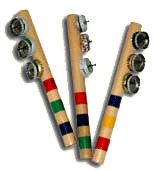 Jingle
Sticks Jingle
Sticks

MATERIALS:
 Six
metal bottle caps for each stick Six
metal bottle caps for each stick
 Six
inch dowels or sticks Six
inch dowels or sticks
 Common
nails, approx. 1 3/4" long Common
nails, approx. 1 3/4" long
 One
nail larger in diameter, to use to punch holes in bottle caps One
nail larger in diameter, to use to punch holes in bottle caps
 Polyurethane or other clear finish Polyurethane or other clear finish
 Optional:
different colored electrical tape, and permanent black marker Optional:
different colored electrical tape, and permanent black marker
INSTRUCTIONS:
Coat dowels with 2 coats of
polyurethane, and allow to dry.Using larger nail, hammer holes in the
centers of the bottle caps.Using common nails, hammer 3 sets of 2 bottle
caps each along one side of the dowel, leaving enough dowel for handle.If
desired, decorate handle end of dowel with bands of electrical tape, and
draw design on tape with maker

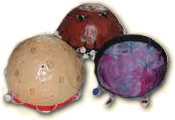 African
Tambourine African
Tambourine

MATERIALS:
 Jar to set balloon in while forming
paper mache Jar to set balloon in while forming
paper mache
 12" balloon 12" balloon
 Masking
or other tape Masking
or other tape
 Awl
or ice pick for punching holes Awl
or ice pick for punching holes
 Hot
glue gun Hot
glue gun
 Newspaper
torn into 1" strips Newspaper
torn into 1" strips
 White
glue and water mixture (1 part glue to 3 parts water) White
glue and water mixture (1 part glue to 3 parts water)
 Acrylic paint Acrylic paint
 1 3/4" wide cloth or duct tape (vinyl
or electrical tape won’t stick well) 1 3/4" wide cloth or duct tape (vinyl
or electrical tape won’t stick well)
 Yarn
or string Yarn
or string
 Cowry
shells, buttons, or beads Cowry
shells, buttons, or beads
( shell necklace is less expensive than individual shells)
INSTRUCTIONS:
Blow up balloon to about 2/3
full size (this is arbitrary). Set the balloon in jar, and lightly tape it
to keep it from rolling around. Dip strips of newspaper in glue and water
mixture, and pull off excess by running paper through fingers. Cover top
half of balloon with several layers of newspaper, and allow to dry for 2
days. When paper mache is dry, remove balloon from jar, and pop it. Using
scissors, cut an even edge around the bottom so you have a bowl shape. Fold
cloth or duct tape over the cut edge of the bowl.
Using an awl or an ice pick, punch holes all around the bowl, just below the
cloth tape, and a couple of inches apart. Thread yarn or string through the
holes, and attach shells or buttons on the outside of the bowl, allowing
them to hang loosely making a sound when the tambourine is moved back and
forth.
COMMENTS:
To play the tambourine, hold
it in both hands, with fingers up, and twist wrists back and forth. Once you
have mastered this, you can gently toss it while twisting your wrists.

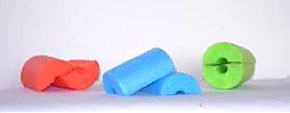 Noodle
"Sand
Blocks" Noodle
"Sand
Blocks"

These "sand blocks" are made from
inexpensive "swimming noodles," which are available just about everywhere
now for a couple of dollars. They are brightly-colored 6 ft long pieces of
foam used for flotation. In my town they are even available at the
supermarket and drug store! If you can't find these (because it's not
summer where you are, or they just aren't available where you live), you
can use the gray foam pipe insulation tubes available at hardware stores.
Not as colorful, but fully functional and still inexpensive. To cut the
noodles, you can use anything from a saw to a utility knife. The best tool
is an electric knife. It makes a clean cut and you can make 30 pairs of
blocks in just a few minutes! Be aware that if you use a saw, you will
have rough pill-y edges which will shed for a while as the children are
playing them. So if you have a choice between a saw and a utility knife, a
utility knife makes a cleaner cut. Just be very careful, and you might
want to mark a circle around the noodle before cutting, since the knife
won't go all the way through. So, once you have selected your cutting
tool... Cut the noodles in about 3-4" pieces, then cut each piece in half
lengthwise.
COMMENTS:
When children rub them together they make
a wonderful sand block sound. And when they "clap" them, as children will
inevitably do, they will make a very nice (quiet!) muffled clap, unlike
wooden sand blocks that are very hard on the ears! Also, they won't cause
injury when thrown ( another inevitable occurrence when working with young
children!). They are washable, inexpensive, colorful, and musical! What
more could you want? I use them with train songs and any song that has
wheels, as you can rub them around in circles. When playing train songs,
you can make a train and walk around the room while playing. Another great
activity, is to play a pattern with your blocks, and have the children
copy it. Older children can take turns being the leader. Or sing nursery
rhymes and keep a rhythm on the blocks. All of these activities are great
for building early literacy skills!

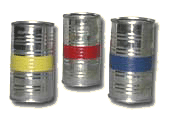 Juice
Can Shakers Juice
Can Shakers

These are fun ethnic-looking shakers– very easy to make!
MATERIALS:
 Juice cans with paper labels Juice cans with paper labels
(Dole Pineapple is the only one
I have found, but you may find others).
 Duct tape Duct tape
 Waxed paper Waxed paper
 Rice or other similar filling Rice or other similar filling
 Hot glue
gun Hot glue
gun
 Electrical tape in different colors (available from hardware stores for
under $2 ) Electrical tape in different colors (available from hardware stores for
under $2 )
INSTRUCTIONS:
Drink the juice, remove the paper labels and pull tab, and
wash and dry the cans. Put a small amount of rice in each can. You can hold
your finger over the top and shake it, to see if it seems like the right
amount. Place a strip of duct tape on waxed paper ( the waxed paper us just
to act as a backing for the tape while you cut it). Trace a circle using the
bottom of the can, and cut out enough duct tape circle to have one for each
can. Peel the waxed paper off, and carefully apple the tape over the top of
each can. Then make a ring of hot glue around the edge of the duct tape to
further seal the top. Lastly, put one piece of electrical tape around the
middle of each can. If you use all four colors, red, blue, yellow, and
green, and have 12 cans, you will end up with 3 cans of each color. You can
then use the songs to learn colors in Spanish (or other languages), such as
Tocan Las Maracas (on Rhythm of the Rocks CD), or try using some of the
egg-shaking songs.

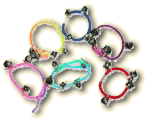 Jingle
Bracelets Jingle
Bracelets

MATERIALS:
 Elastic
ponytail holders or Chinese jump rope Elastic
ponytail holders or Chinese jump rope
(one jump rope will make 7 jingle bracelets)
 Elasticized
gold thread Elasticized
gold thread
 Scissors Scissors
 Jingle
bells (available by the handful at craft and fabric stores, Jingle
bells (available by the handful at craft and fabric stores,
or on cards at variety stores)
INSTRUCTIONS:
If using Chinese jump rope,
cut into seven inch lengths, and form form bracelets by tying ends in a
knot.
Using elasticized thread, tie 4 jingle bells on each bracelet, Space them
equally around the bracelet.
COMMENTS:
Songs which use hand movements are quite fun when using these
bracelets. examples: Tingalayo (can be found on Raffi recording), and A
Rum Sum Sum (can be found on Rhythm of the Rocks, by MaryLee and
Nancy)

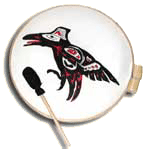 Quilting
Hoop Drum Quilting
Hoop Drum

MATERIALS:
 14" quilting hoop (available at craft
and fabric stores) 14" quilting hoop (available at craft
and fabric stores)
 White
glue White
glue
 Heat-shrink nylon fabric (sold at
airplane supply stores- you can order from Heat-shrink nylon fabric (sold at
airplane supply stores- you can order from
Aircraft Spruce & Specialty Co.
(item # 09-00500)
One yard of fabric will be enough for 8 14"
drums, and is under $4 a yard).
 Clear polyurethane
and brush to apply
it Clear polyurethane
and brush to apply
it
 Acrylic
paint or permanent markers for making design on drum Acrylic
paint or permanent markers for making design on drum
 Wooden
dowel Wooden
dowel
 Wooden
ball with pre-drilled hole the same size diameter as the dowel Wooden
ball with pre-drilled hole the same size diameter as the dowel
INSTRUCTIONS:
Cut a 17" square of dacron.
Spread a bead of glue on opposing faces of the two hoops. Place the inner
hoop on a flat surface and overlay the fabric square so that the sides
overhang evenly. Loosen the nut on the outer hoop so you can spread it
enough to fit it over the inner hoop. Tighten the wing nut as you adjust the
fabric, working out any wrinkle and puckers. Let glue dry. Heat-shrink the
fabric by running an iron at the nylon setting repeatedly over the fabric.
(each drum will tighten a little differently and have a slightly different
sound).Trim the excess fabric with an exacto knife. Paint a design on the
drum, if desired, and finish by sealing all surfaces with a coating of clear
polyurethane.
Make the drumstick by cutting a dowel in 8" piece. Glue small wooden ball on
the end.
|



